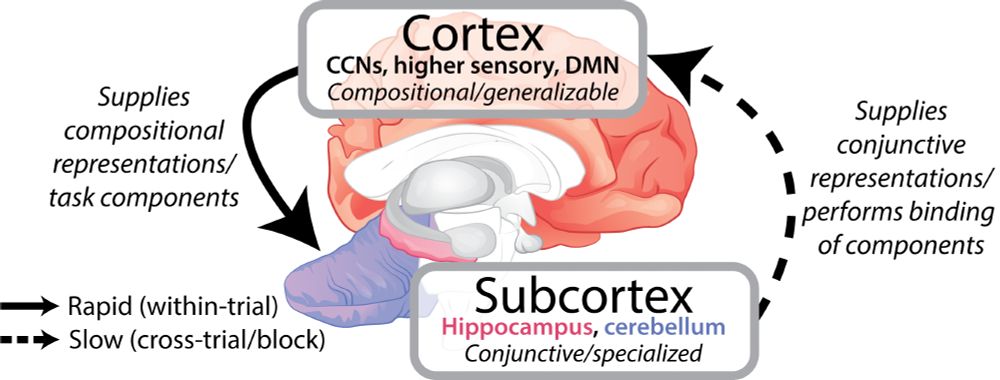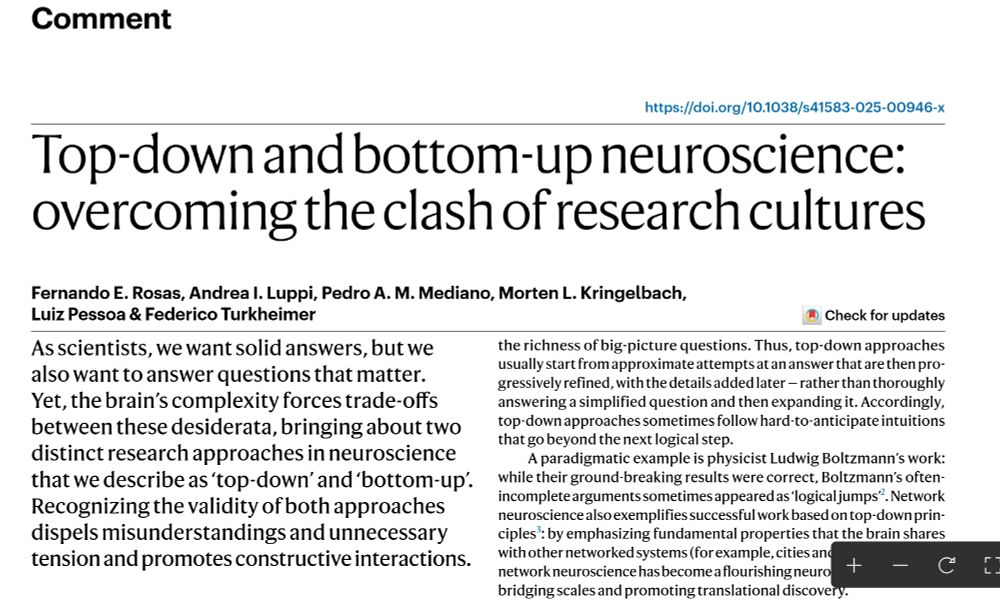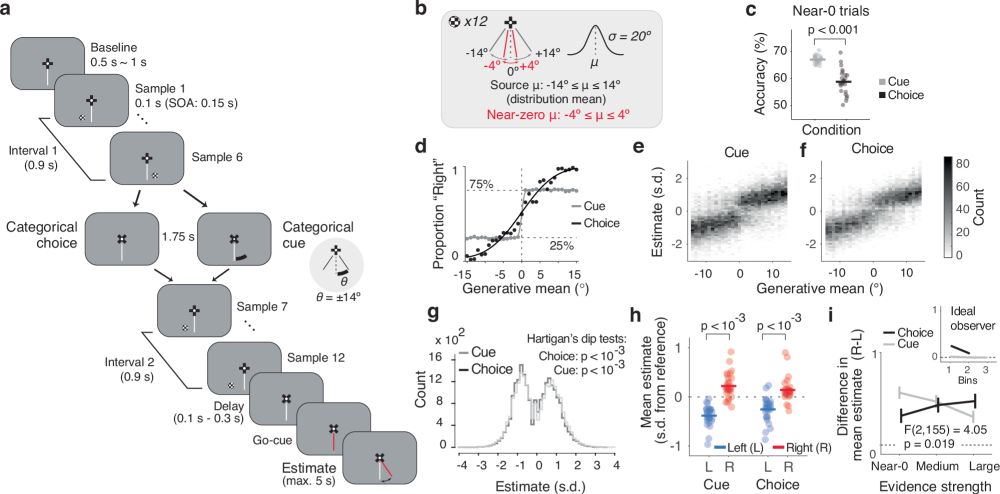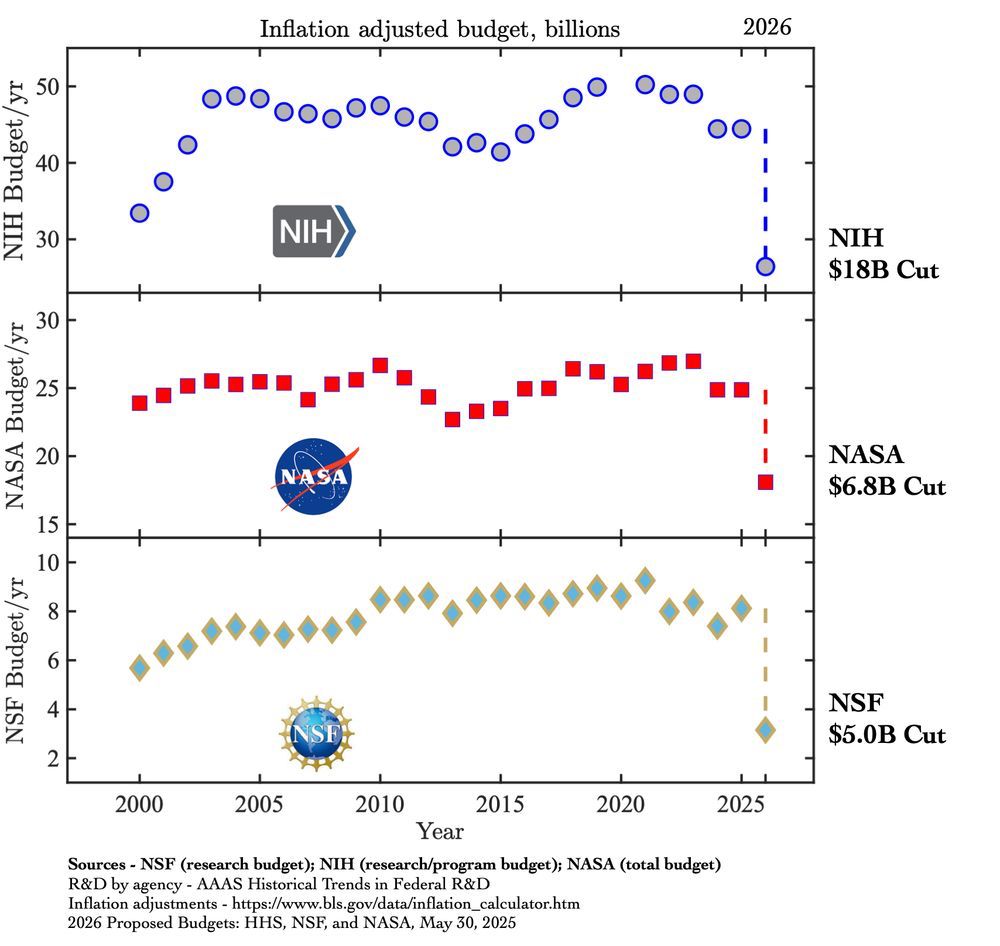
10) Please check out the full paper here: “Dynamically shifting from compositional to conjunctive brain representations supports cognitive task learning”, doi.org/10.1038/s414...
20.11.2025 17:07 — 👍 2 🔁 1 💬 0 📌 0@mwcole.bsky.social
Professor, director of neuroscience lab at Rutgers University – neuroimaging, cognitive control, network neuroscience Writing book “Brain Flows: How Network Dynamics Generate The Human Mind” for Princeton University Press https://www.colelab.org

10) Please check out the full paper here: “Dynamically shifting from compositional to conjunctive brain representations supports cognitive task learning”, doi.org/10.1038/s414...
20.11.2025 17:07 — 👍 2 🔁 1 💬 0 📌 0
Schematic depicting cortical-subcortical interactions during multi-task learning
Excited to see our paper with @mwcole.bsky.social finally out in peer-reviewed form @natcomms.nature.com! We examine how the human brain learns new tasks and optimizes representations over practice…1/n
19.11.2025 18:03 — 👍 24 🔁 7 💬 1 📌 02/3 Imagine if NFL coaches were hired because they were friends with the White House. You’d end up with bad football teams pretty fast. Same deal with NIH IC Directors and science.
23.10.2025 04:11 — 👍 118 🔁 24 💬 2 📌 2Wanna better understand what society has gained from research? This website crowd-sources societal benefits that stem from US government-funded research publicusaresearchbenefits.com
19.09.2025 19:15 — 👍 8 🔁 4 💬 0 📌 1Yes! bsky.app/profile/mwco...
19.09.2025 15:05 — 👍 2 🔁 0 💬 1 📌 0I think both of those explanations are plausible. I co-authored a paper on functional/effective connectivity in 2019 that may be helpful: Reid et al. (2019). "Advancing functional connectivity research from association to causation". Nature Neuroscience. www.colelab.org/pubs/Reid201...
17.09.2025 01:43 — 👍 1 🔁 0 💬 1 📌 0Ideally, regularized partial correlation would have become the default back then. Instead, 90%+ of studies have continued to use pairwise correlations, especially with fMRI. I think one reason is that the advantages of the new approach hadn't been shown clearly, which is what we try to do here.
16.09.2025 15:20 — 👍 2 🔁 0 💬 2 📌 0The graphical lasso functional connectivity approach that performed best in the paper can be implemented using the Activity Flow Toolbox: colelab.github.io/ActflowToolb...
And also using the paper's code release: github.com/ColeLab/Reli... [12/n]

Together, results demonstrated vast improvements in fMRI functional connectivity estimation using regularized partial correlation. Thanks to first author Kirsten Peterson, and coauthors Ruben Sanchez-Romero and
@ravimill.bsky.social!
doi.org/10.1162/IMAG... #neuroscience #neuroimaging [11/n]

And regularization improved prediction of individual differences in demographics (age) and behavior/cognition (general intelligence) relative to standard partial correlation. The glasso results were more interpretable than pairwise correlation (fewer false connections) 10/n
14.09.2025 21:34 — 👍 3 🔁 0 💬 1 📌 0
Also empirical, prediction of task-evoked activity (via activity flow modeling) was better with regularized partial correlation 9/n
14.09.2025 21:34 — 👍 4 🔁 0 💬 1 📌 0As another empirical validation, regularized partial correlation was much less susceptible to motion artifacts than pairwise correlation. Percent connections linked to motion = Pairwise correlation FC: 56.4% vs. graphical lasso FC: 0.01% 8/n
14.09.2025 21:34 — 👍 2 🔁 0 💬 1 📌 0
First empirical validation: regularized partial correlation was much closer to structural connectivity, which doesn’t have the causal confounding problem (despite other issues) 7/n
14.09.2025 21:34 — 👍 3 🔁 0 💬 1 📌 0
This pattern of results was mirrored in empirical resting-state fMRI data across 4 validation measures. Regularization was key to estimating individual subject-level networks with reduced confounding. 6/n
14.09.2025 21:34 — 👍 2 🔁 0 💬 1 📌 0
In simulations, pairwise (standard) correlation led to many false connections, but so did partial correlation. Regularized partial correlation (glasso) better recovered the true network organization 5/n
14.09.2025 21:34 — 👍 3 🔁 0 💬 1 📌 0
We hypothesized that low reliability of partial correlation is due to overfitting to noise, with regularization (model simplification) improving reliability. 4/n
14.09.2025 21:34 — 👍 2 🔁 0 💬 1 📌 0
Pairwise correlations are known to be susceptible to false positives in theory. For example, region A causing activity in unconnected regions B and C (B<-A->C) can lead to a false B-C connection. Partial correlation can correct for this error, but not reliably 3/n
14.09.2025 21:34 — 👍 2 🔁 0 💬 1 📌 0In brief: Improvements to pairwise (standard) correlation: 1) reduced false connections (confounding), 2) reduced sensitivity to in-scanner motion, 3) better correspondence to task-related activity, and 4) more interpretable links with individual differences in behavior 2/n
14.09.2025 21:34 — 👍 2 🔁 0 💬 1 📌 0
Lab’s latest is out in Imaging Neuroscience, led by Kirsten Peterson: “Regularized partial correlation provides reliable functional connectivity estimates while correcting for widespread confounding”, where we demonstrate a major improvement to standard fMRI functional connectivity (correlation) 1/n
14.09.2025 21:34 — 👍 74 🔁 30 💬 5 📌 0
New paper in Imaging Neuroscience by Malte R. Güth, Travis E. Baker, et al:
Right posterior theta reflects human parahippocampal phase resetting by salient cues during goal-directed navigation
doi.org/10.1162/IMAG...
Ask courageous questions.
Do not be satisfied with superficial answers. Be open to wonder and at the same time subject all claims to knowledge, without exception, to critical scrutiny.
Be aware of human fallibility.
Cherish your species and your planet.
- Carl Sagan.
I still get chills
Meet Mike
*30+ years severe depression
*first hospitalized @ 13y
*20 meds
*3 rounds of ECT
*2 near-fatal suicide attempts
Mike felt joy for the first time in decades after we turned on his new brain pacemaker or PACE
see videos, read paper, follow thread
doi.org/10.31234/osf...

“Top-down and bottom-up neuroscience: overcoming the clash of research cultures”
doi.org/10.1038/s415...
Small contribution in this piece by @frosas.bsky.social and colleagues on how we need both types of research culture in neuroscience.
#neuroskyence
Maybe being anxious is a sign of being a good scientist? Accurate theories/hypotheses should stand up to many tests developed from a skeptical perspective. Starting from empirical constraints & modeling their interaction can help keep theories grounded, perhaps increasing the odds they'll be correct
11.07.2025 14:08 — 👍 1 🔁 0 💬 0 📌 0Once you have a flow model that generates a phenomenon of interest, you can lesion each empirical constraint (e.g., each connection or task-evoked activation) to determine which contributed to generation of that phenomenon. Follow-up empirical stimulation or lesion work can further verify this.
11.07.2025 13:35 — 👍 1 🔁 0 💬 1 📌 0I agree these are vexing problems that need more solutions. An approach that's working for us is to integrate empirical constraints into generative models. Connectivity and task response data used to form activity flow models (empirical neural networks). Details here: www.colelab.org/pubs/2024_Ac...
11.07.2025 12:33 — 👍 3 🔁 0 💬 1 📌 0Exciting new preprint from the lab: “Adopting a human developmental visual diet yields robust, shape-based AI vision”. A most wonderful case where brain inspiration massively improved AI solutions.
Work with @zejinlu.bsky.social @sushrutthorat.bsky.social and Radek Cichy
arxiv.org/abs/2507.03168

1/ New paper by Hame Park, (@AraziAyelet), Bharath Talluri, Marco Celotto, Stefano Panzeri, Alan Stocker & Tobias Donner published in Nature Communications – “Confirmation Bias through Selective Readout of Information Encoded in Human Parietal Cortex”: rdcu.be/etlR7. Here is a summary:
27.06.2025 13:35 — 👍 38 🔁 20 💬 1 📌 0Check out my newest preprint to see the TCP dataset in action! 🤘🧠
Brain network dynamics reflect psychiatric illness status and transdiagnostic symptom profiles across health and disease: www.biorxiv.org/content/10.1...

NSF, NASA and NIH budgets per year, inflation adjusted from 2000-2025 along with the proposed cuts. NSF includes research component only. Massive cuts across all sectors, well below support spanning 25 years.
The President's Budget request as released yesterday will gut scientific research. Why should you care?
1) Science is fundamentally a jobs program. Many 100,000s are employed to do science and work for you, the US taxpayer.